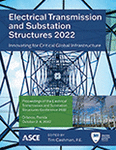Electrical Transmission and Substation Structures 2022
Adaptive Foundation Design of Power Lines Reduces Schedule and Coordination Challenges of Field Geotechnical Investigations
Publication: Electrical Transmission and Substation Structures 2022: Innovating for Critical Global Infrastructure
ABSTRACT
Early collaboration between the utility and its line and foundation designers provides sequencing and adjustment to field geotechnical data collection protocols and associated foundation design. This paper presents application of the demonstrated benefits of adaptive foundation design for several projects across the U.S. Grid modernization, renewable energy integration, and demand changes have been driving rebuilding of power transmission lines within existing right-of-way and construction of new lines built in green fields, often through difficult terrains. Design and optimization of foundations for tower structures have critical impacts to cost and schedule. Traditionally, geotechnical investigations involving drilling of soil borings with heavy machineries have been conducted in the early phase of projects to obtain soil data. However, obtaining such field data early in the project poses several difficulties such as addressing access issues, landowner sensitivity and coordination requirements, synchronizing with de-energizing schedule, mitigating safety hazards including fire risks, noises, avoiding impact to vegetation, and sensitive species. In addition, accurate foundation locations and loads are often not established in early project planning phases and weather events add huge variability to the schedule. Over the last two decades desktop studies have been increasingly used in the industry to address some of these challenges. Desktop studies collect published geological information to further target field data collection locations often reducing or better targeting the needed number of borings. A natural progression is to further refine desktop studies with soil mapping and limited soil borings to customize preliminary soil design parameters. These parameters are then employed for estimating foundation sizes and sensitivity analyses are performed, where needed. Many utilities also have standard foundation designs for established soil profiles which further aids this approach. When access and tower locations are better established at, or before construction, a targeted verification soil boring program can validate earlier assumptions and adjust foundation sizes. This adaptive foundation design provides greater flexibility to the project. Verification borings at the actual locations of heavily loaded towers provides greater accuracy. Construction contracting mechanisms can accommodate for some anticipated changes to length and size of foundations through pre-established unit rates. The phased approach blends the limited availability of access, the schedule, and the risk tolerance to provide a dependable means of foundation design.
Get full access to this article
View all available purchase options and get full access to this chapter.
REFERENCES
Yamatani, K. and Jahangir, A. (2011). “Mitigating Risk and Managing Foundation Cost & Schedule on ‘Mega’ Transmission Line Projects: Beginning with the End in Mind.” GeoRisk 2011; Geotechnical Risk Assessment & Management.
Information & Authors
Information
Published In
Electrical Transmission and Substation Structures 2022: Innovating for Critical Global Infrastructure
Pages: 310 - 320
Editor: Tim Cashman
ISBN (Online): 978-0-7844-8446-3
Copyright
© 2022 American Society of Civil Engineers.
History
Published online: Sep 20, 2022
Published in print: Sep 20, 2022
Authors
Metrics & Citations
Metrics
Citations
Download citation
If you have the appropriate software installed, you can download article citation data to the citation manager of your choice. Simply select your manager software from the list below and click Download.
